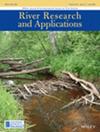鳕鱼(Alosa pseudoharengus)和蓝背鲱鱼(Alosa aestivalis)非过渡性上游通道的局限性
IF 1.9
4区 环境科学与生态学
Q4 ENVIRONMENTAL SCIENCES
引用次数: 0
摘要
我们使用 PIT 遥测技术(n = 10,292 条被标记的鱼)评估了一条非波动性鱼道(诱捕器、提升机和卡车)的上游通过情况,该鱼道在 2020 年至 2023 年期间通过了新不伦瑞克省沃拉斯托克/圣约翰河最下游大坝周围约 1,000 万条鲱鱼(桤鱼 Alosa pseudoharengus 和蓝背鲱 A. aestivalis)。26% 到 62% 的标记鱼到达了鱼道拥挤水池,而只有不到 14% 的鱼被检测到通过上游。河鲱鱼在到达鱼道入口后会经历相当长的通过延迟(中位数 = 3 天)。首次发现之日通过的概率仅为 10%,且与鱼道运行率(即鱼群提升/单位时间)呈正相关。金目鲱的通过率和通过概率均高于蓝背鲱,且两种鱼的通过率和通过概率均随鱼体总长度的增加而增加。总之,我们的研究结果表明,鱼道的通过效率和持续时间受限于鱼道的移动能力和运行频率,以及在特定时间内试图通过的(大量)鱼类。最终,如果非波动性鱼道的设计和运行不能适应目标种群的大小和行为(即洄游密度和洄游时间),我们的结果表明,潜在的后果可能包括通过延迟、通过效率降低以及对目标种群的选择性压力(如大小和物种)。本文章由计算机程序翻译,如有差异,请以英文原文为准。
Limitations of Non‐Volitional Upstream Passage for Alewife (Alosa pseudoharengus) and Blueback Herring (Alosa aestivalis)
We used PIT telemetry (n = 10,292 fish tagged) to evaluate upstream passage at a non‐volitional fishway (trap, lift, and truck) that passed approximately 10‐million river herring (alewife Alosa pseudoharengus and blueback herring A . aestivalis ) around the lowermost dam in the Wolastoq/Saint John River, NB between 2020 and 2023. Between 26% and 62% of tagged fish reached the fishway crowding pool, while less than 14% were detected passing upstream. River herring experienced considerable passage delays (median = 3 days) after reaching the crowder entrance. The probability of passing on the date of first detection was only 10%, and it was positively correlated with the rate of fishway operation (i.e., fish lifts/unit time). The rate and probability of passage were greater for alewife than blueback herring and increased with total length for both species. Collectively, our results suggest that passage efficiency and duration were limited by the movement capacity and operation frequency of the fishway, and potentially the (high) number of fish attempting to pass at a given time. Ultimately, if the design and operation of non‐volitional fishways do not accommodate the size and behavior (i.e., schooling density and migration time) of target populations, our results indicate that potential consequences may include passage delays, reductions in passage efficiency, and selective pressures (e.g., size and species) on target populations.
求助全文
通过发布文献求助,成功后即可免费获取论文全文。
去求助
来源期刊

River Research and Applications
环境科学-环境科学
CiteScore
4.60
自引率
9.10%
发文量
158
审稿时长
6 months
期刊介绍:
River Research and Applications , previously published as Regulated Rivers: Research and Management (1987-2001), is an international journal dedicated to the promotion of basic and applied scientific research on rivers. The journal publishes original scientific and technical papers on biological, ecological, geomorphological, hydrological, engineering and geographical aspects related to rivers in both the developed and developing world. Papers showing how basic studies and new science can be of use in applied problems associated with river management, regulation and restoration are encouraged as is interdisciplinary research concerned directly or indirectly with river management problems.
 求助内容:
求助内容: 应助结果提醒方式:
应助结果提醒方式:


